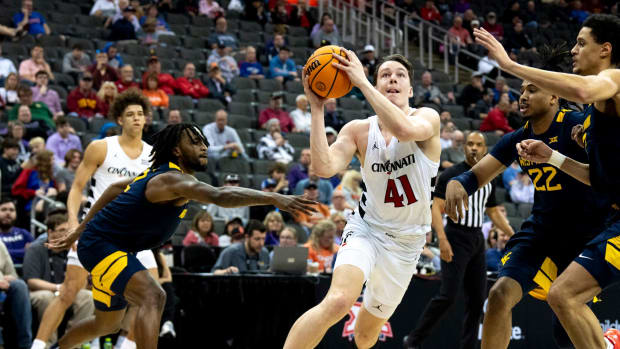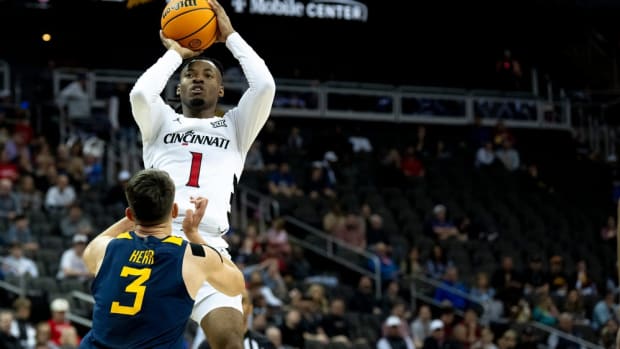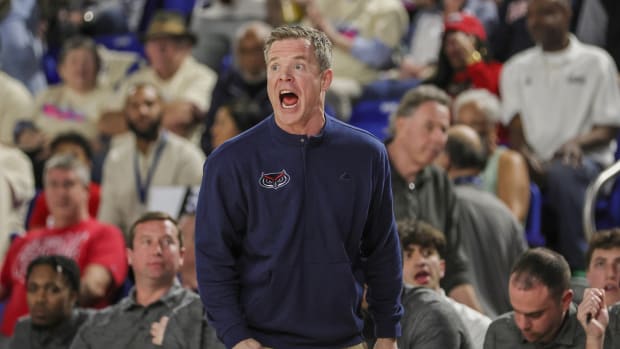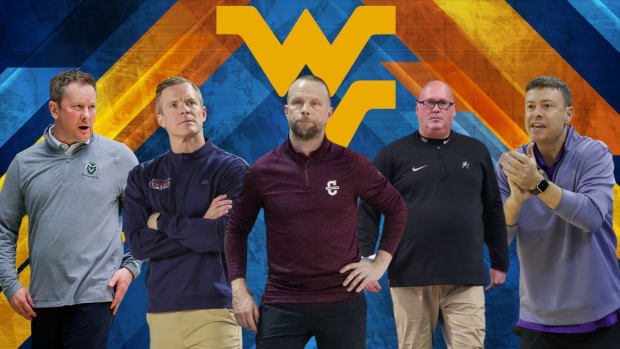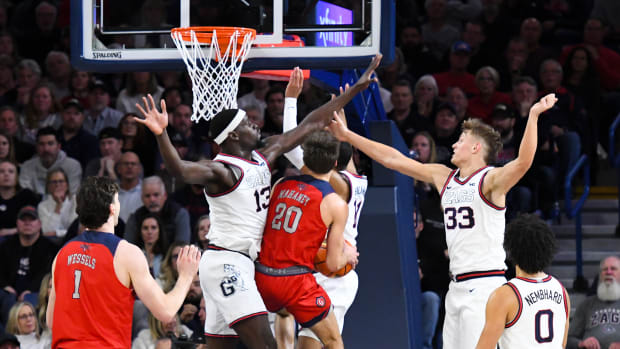Jayhawks' Mason makes play of night as Kansas, Kentucky win at Champions Classic
NEW YORK — On the first can’t-miss night of college basketball’s young season, about a dozen players who are expected to be selected in the first round of the NBA draft streamed into the world’s most famous arena. But Frank Mason, a 5' 11" senior guard who originally committed to Towson before becoming a Kansas star, overshadowed all of them when he hit an iso, step-back game-winner to give the No. 7 Jayhawks a 77–75 win over No. 1 Duke. With one swish, Mason reset the college basketball conversation back to the upperclassmen—at least for a night. Kansas’s triumph came after No. 2 Kentucky rolled over No. 13 Michigan State, 69–48, in the Champions Classic undercard. Because it’ll be at least a few weeks before any of them take on another ranked opponent, here is a key takeaway for each team:
Kansas (1–1)
Frank Mason’s game-winner will be the most memorable moment of the night, but he was brilliant throughout the entire game. He offered the Jayhawks 21 points, five assists and two steals in 35 minutes to help them avoid their first 0–2 start since 1973. “If Frank hadn’t gotten in foul trouble early,” Bill Self told reporters after the game, “he would have played 40 minutes as well.”
Mason and junior guard Devonte’ Graham—whom Self affectionately refers to as “the two littles”—give Kansas college basketball’s most coveted advantage: A veteran backcourt. Even better, they are both point guards, and they each can create their own shots and lock down much larger and more imposing guards. After a first half in which the Jayhawks went 1-for-12 from the three-point line, Self reminded his players—and particularly his two guards—that they let opponents off the hook when they settled for contested jumpers. “He tells us nobody can guard us or stay in front of us,” Graham said.
Kris Jenkins: What hitting the game-winning shot meant to me
Over and over again on Tuesday night, and particularly in the late second half as Duke mounted its near comeback, Mason slipped by Duke’s guards and bodied their big men, seemingly scoring at will in the lane. It was the threat of his penetration to the paint that allowed him to create enough separation from Duke’s Matt Jones to step back and sink the surefire SportsCenter Top 10 shot. “It was quite a play we called—just get out of his way,” Self joked. “He’s a stud.”
Kansas, which was a consensus Final Four team in our experts’ predictions for the season, has plenty of reason to believe they’ll play into April after Tuesday night’s performance. Before he fouled out, No. 1 overall recruit Josh Jackson showed his ability to take over a game, and sophomores Carlton Bragg and Lagerald Vick appear poised for breakout sophomore seasons. But the Jayhawks’ season will ultimately rest on the success of Mason and Graham.
Kentucky (3–0)
All last year, Isaiah Briscoe told coach John Calipari he was a shooter. But in the 2015–16 season he averaged 13.5% from three and 46.0% from the free-throw line. “I told him,” Calipari joked after the win over Michigan State, “‘You’re a shooter, but you’re not a maker.’” Briscoe has barely improved as a jump shooter this season—according to hoop-math.com, he came into Tuesday night averaging 20.0% on two-point jumpers and he’s a 33.0% three-point shooter—but he has nevertheless become a reliable scorer. Briscoe led all Kentucky scorers in the team’s two wins against Stephen F. Austin and Canisius, and he was second (21 points) behind Malik Monk (23) against the Spartans.
For Kentucky, Briscoe’s weakness as a jump shooter could even be perceived as a strength for the team. While the Wildcats have struggled as a team to shoot—through three games, they’re averaging 26.5% from beyond the arc—Briscoe’s buckets come largely from driving and hitting layups or from the free-throw line, where he is getting 5.3 times per night and has improved to a 63.6% shooter. “He’s way more mature,” Calipari said. “He’s way more comfortable in how we’re playing. He has a will to win.”
He still may not be a shooter, but Briscoe has earned his coach’s trust. As the season continues, Kentucky’s three-point shooting seems bound to improve, and the Wildcats will probably turn that part of the offense over to freshmen Malik Monk and De’Aaron Fox, but Briscoe will continue to be critical for the Wildcats’ success.
Expert Predictions: SI writers make picks for Final Four, Player of the Year, more
Duke (2–1)
Before the season, my colleague Luke Winn ran a series of “What If?” questions through the projections system he runs along with the economist Dan Hanner. Among them was: “What if none of Duke’s freshman had enrolled this season?” The answer was that the Blue Devils—our preseason No. 1 team by a significant margin—would drop to No. 12. Although Duke did have the services of five-star point guard Frank Jackson and four-star big man Javin DeLaurier in New York, freshmen Harry Giles (knee), Jayson Tatum (foot) and Marques Bolden (lower leg) wore matching suits on the sidelines. Without them, Duke effectively played just six men (DeLaurier recorded no stats in one minute on the floor.) And without them, it’s difficult to evaluate how good Duke will be.
“I think we’re a good team, otherwise we would have gotten blown out tonight,” Duke coach Mike Krzyzewski said. “But we’re a limited team. We’re not yet where we imagined we’d be...But we didn’t lose because we were short-handed. We lost because Kansas played better than we did.”
One shot: North Carolina's Isaiah Hicks has a last chance to make his own history
Overall, Coach K seemed to leave the game with a positive impression of his team. And he should—without most of his freshmen and with an uncharacteristically inefficient and injury-hampered performance from Player of the Year frontrunner Grayson Allen, the Blue Devils still finished within a bucket of one of the best teams in the country. It’s not hard to imagine a Duke squad at full health (or even near it) reversing the outcome of this matchup in March.
Michigan State (0–2)
After two games, the Spartans look much more like the 28th-ranked team that SI projected them to be than No. 13, their preseason ranking in the AP poll. If you had predicted a problem area for the Spartans before the season, it would have been their thin frontcourt. After unexpectedly losing Deyonta Davis to the NBA draft in the spring, Michigan State saw two big men—potential starting center Gavin Schilling and graduate transfer Ben Carter—go down with injuries in October. And yet, the Spartans managed to equal Kentucky’s scoring in the paint and even outrebounded the Wildcats on Tuesday night. Instead, the Spartans are facing a much scarier issue: poor guard play.
Against Arizona on Friday night in Hawaii, Michigan State coughed the ball up 18 times, and that total ballooned to 20 against Kentucky. Even worse, the team only had nine assists on Tuesday night. The Spartans’ trio of starting guards—Eron Harris, Matt McQuaid and Tum Tum Nairn—combined to score just 7 points on 3-for-13 shooting and to commit four turnovers against four assists. After the game, coach Tom Izzo told reporters plainly, “Our problems were the turnovers and the offense.”
The anemic offensive performances have wasted excellent defensive efforts in which the Spartans held top-10 teams to 38.5% (Arizona) and 38.3% (Kentucky) on field goals. For now, Izzo must hope that Harris adjusts to a more prominent offensive role and that hyped freshman Miles Bridges (who scored six points on 2-for-11 shooting and turned the ball over nine times) grows up quickly. It’s far too early to bet against an Izzo-coached team, but Michigan State has some marked problems on offense that won’t be easy to solve.

